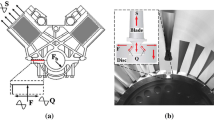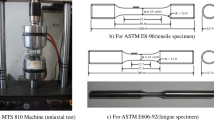Abstract
The contact surface between the aero-engine turbine blade and the disk dovetail junction structure is small, which results in severe fretting fatigue. The fretting fatigue of the structure is sharply aggravated by the plastic effect under the action of alternating loads. The existing fatigue life estimation model may need to be improved in considering fretting and plastic effects, making the result greatly differ from those found in practice. Accordingly, this work intends to propose a fretting fatigue life estimation model based on plastic effects and standard surface-to-surface contact theory. The distribution of both the equivalent and contact stresses found in the contact area was analyzed using finite elements. The aim was to determine the fatigue critical point of the structure. The maximum cyclic load stress value was obtained through the fretting fatigue experiments to verify the model accuracy. The model applicability was verified and analyzed using dovetail experiments. The experimental results have shown that the error between the values obtained using the proposed estimation model and experiment is below 12%, meaning that the accuracy is high. Therefore, the estimation model is suitable for estimation the dovetail structure fretting fatigue life. This paper provides theoretical support for the design of the dovetail tenon structure. The contact surface between the aero-engine turbine blade and the dovetail junction structure is small, which results in severe fretting fatigue. The fretting fatigue of the structure is sharply aggravated by the plastic effect under the action of alternating loads. The existing fatigue life estimation model may need to be improved in considering fretting and plastic effects, making the result greatly differ from those found in practice. Accordingly, this work intends to propose a fretting fatigue life estimation model based on plastic effects and standard surface-to-surface contact theory. The finite element analysis is used to analyze the distribution of equivalent stress and contact stress in the contact area, in order to determine the fatigue risk point of the structure. The accuracy of the model is verified by obtaining the maximum cyclic load stress value through the fretting fatigue experiment. The universal applicability of the model is verified through the dovetail experiment analysis. The experimental results show that the error between the theory and experiment of the proposed estimation model is below 12%. Therefore, it is suitable for the estimation of the fretting fatigue life of the dovetail structure.













Similar content being viewed by others
Data availability
The data will be available on reasonable request to the corresponding author.
Abbreviations
- D crit :
-
Critical damage
- D :
-
Damage variable
- A :
-
Undamaged surface cross-section area
- Ã :
-
Effective load area (which is the actual area)
- \(\sigma\) :
-
Axial stress
- \(\tilde{\sigma }\) :
-
Effective stress
- \(\varepsilon\) :
-
Strain
- F :
-
Force
- E :
-
Undamaged elastic modulus
- Ẽ :
-
Damaged elastic modulus
- σ fretting :
-
Fretting stress
- N :
-
Life
- N f :
-
Remaining life
- σ 0 :
-
Peak axial stress
- p h :
-
Maximum contact area load
- μ :
-
Friction coefficient on the contact surface
- F T :
-
Tangential load amplitude between standard sample and contact pad
- F N :
-
Normal load
- σ R :
-
Material resistance stress
- m :
-
Material parameter
- Δε_p :
-
The maximum plastic strain range
- ω :
-
Is the fitting parameter
- K N :
-
Generalized stress intensity factor of the normal stress distribution
- a round :
-
Load contact area radius
- t :
-
Horizontal contact edge coordinate
- R :
-
Edge radius
- E* :
-
Elastically similar materials
- ρ :
-
Density
- f :
-
Frequency
- ν :
-
Poisson's ratio
References
Pereira K, Abdel Wahab MA (2017) Fretting fatigue crack propagation lifetime prediction in cylindrical contact using an extended MTS criterion for non-proportional loading. Tribol Int 115:525–534. https://doi.org/10.1016/j.triboint.2017.06.026
Sharma A, Sadeghi F, Sharma A (2020) Experimental investigation of fretting wear of coated spring clip and inlet ring in land-based gas turbines at elevated temperature - ScienceDirect. Wear. https://doi.org/10.1016/j.wear.2020.203200
Lemoine E, Nélias D, Thouverez F, Vincent C (2020) Influence of fretting wear on bladed disks dynamic analysis. Tribol Int. https://doi.org/10.1016/j.triboint.2020.106148
Li ZY, Liu XL, Wu GQ, Sha W (2017) Observation of fretting fatigue cracks of Ti6Al4V titanium alloy. Mater Sci Eng, A 707:51–57. https://doi.org/10.1016/j.msea.2017.09.005
Araújo JA, Almeida GMJ, Ferreira JLA, da Silva CRM, Castro FC (2016) Early cracking orientation under high stress gradients: the fretting case. Int J Fatigue 100:611–618. https://doi.org/10.1016/j.ijfatigue.2016.12.013
Vantadori S, Valeo JV, Zanichelli A (2020) Fretting fatigue and shot peening: a multiaxial fatigue criterion including residual stress relaxation. Tribol Int. https://doi.org/10.1016/j.triboint.2020.106537
Bhatti NA, Abdel Wahab M (2018) Fretting fatigue damage nucleation under out of phase loading using a continuum damage model for non-proportional loading. Tribol Int 121:204–213. https://doi.org/10.1016/j.triboint.2018.01.038
Bhatti NA, Pereira K, Abdel Wahab MA (2017) A continuum damage mechanics approach for fretting fatigue under out of phase loading. Tribol Int 117:39–51. https://doi.org/10.1016/j.triboint.2017.08.009
Arnaud P, Fouvry S (2019) Modeling the fretting fatigue endurance from partial to gross slip: the effect of debris layer - ScienceDirect. Tribol Int. https://doi.org/10.1016/j.triboint.2019.106069
Pinto AL, Araújo JA, Talemi R (2021) Effects of fretting wear process on fatigue crack propagation and life assessment. Tribol Int. https://doi.org/10.1016/j.triboint.2020.106787
Araújo JA, Susmel L, Pires MST, Castro FC (2016) A multiaxial stress-based critical distance methodology to estimate fretting fatigue life. Tribol Int 108:2–6. https://doi.org/10.1016/j.triboint.2016.07.028
Fleury RMN, Hills DA, Barber JR (2016) A corrective solution for finding the effects of edge-rounding on complete contact between elastically similar bodies. Part I: contact law and normal contact considerations. Int J Solids Struct 85–86:89–96. https://doi.org/10.1016/j.ijsolstr.2015.11.031
Mario L, Daniele B (2018) Fretting fatigue analysis of additively manufactured blade root made of intermetallic Ti-48Al-2Cr-2Nb alloy at high temperature. Materials. https://doi.org/10.3390/ma11071052
Liang S, Wei DS, Wang YR (2016) An investigation of fretting fatigue in a circular arc dovetail assembly. Int J Fatigue 82:226–237. https://doi.org/10.1016/j.ijfatigue.2015.07.025
Bhatti NA, Wahab MA (2017) A numerical investigation on critical plane orientation and initiation lifetimes in fretting fatigue under out of phase loading conditions. Tribol Int 115:307–318. https://doi.org/10.1016/j.triboint.2017.05.036
Walvekar AA, Leonard BD, Sadeghi F, Jalalahmadi B, Bolander N (2014) An experimental study and fatigue damage model for fretting fatigue. Tribol Int 79:183–196. https://doi.org/10.1016/j.triboint.2014.06.006
Han Q, Rui S, Qiu W, Su Y, Ma X, He Z, Cui H, Zhang H, Shi HJ (2019) Subsurface crack formation and propagation of fretting fatigue in Ni-based single-crystal superalloys. Fatigue Fract Eng Mater Struct 42(11):2520–2532. https://doi.org/10.1111/ffe.13049
Wei D-S, Shi L, Wang Y-R (2015) Cyclic plastic behavior of dovetail under fretting load. Eng Fail Anal 55:100–114. https://doi.org/10.1016/j.engfailanal.2015.05.009
Gandiolle C, Fouvry S (2015) FEM modeling of crack nucleation and crack propagation fretting fatigue maps: plasticity effect. Wear 330–331:136–144. https://doi.org/10.1016/j.wear.2015.01.037
Hu Z, Lu W, Thouless MD, Barber JR (2016) Effect of plastic deformation on the evolution of wear and local stress fields in fretting. Int J Solids Struct 82:1–8. https://doi.org/10.1016/j.ijsolstr.2015.12.031
Noraphaiphipaksa N, Manonukul A, Kanchanomai C, Mutoh Y (2016) Fretting-contact-induced crack opening/closure behaviour in fretting fatigue. Int J Fatigue 88:185–196. https://doi.org/10.1016/j.ijfatigue.2016.03.029
Tobi ALM, Sun W, Shipway PH (2017) Evolution of plasticity-based wear damage in gross sliding fretting of a Ti-6Al-4V non-conforming contact. Tribol Int 113:474–486. https://doi.org/10.1016/j.triboint.2017.01.010
Mohd Tobi AL, Sun W, Shipway PH (2016) Investigation on the plasticity accumulation of Ti-6Al-4V fretting wear by decoupling the effects of wear and surface profile in finite element modelling. Tribol Int 113:448–459. https://doi.org/10.1016/j.triboint.2016.12.009
Andresen H, Hills DA (2019) A review of partial slip solutions for contacts represented by half-planes including bulk tension and moments. Tribol Int. https://doi.org/10.1016/j.triboint.2019.106050
Hills DA, Thaitirarot A, Barber JR (2012) Correlation of fretting fatigue experimental results using an asymptotic approach. Int J Fatigue. https://doi.org/10.1016/j.ijfatigue.2012.02.006
Nan W, Haitao C, Hongjian Z (2018) High temperature and low cycle fretting fatigue test of tenon joint structure. J Aeronaut Dyn 033(012):3007–3012
Bowei Wu, Hongjian Z, Haitao C (2019) High temperature fretting fatigue life prediction model based on continuum damage mechanics[J]. J Aeronaut Dyn 34(03):151–158
Funding
This work is supported by NSFC-Liaoning United Key Fund (Grant No. U1708255), National key R & D plan of China (Grant No. 2018YFB1306701), and National Natural Science Foundation of China (Grant No. 51875076).
Author information
Authors and Affiliations
Contributions
Study design: JH, BY, and JD. Study conduct: JH, BY, and RR. Data collection, analysis and interpretation: BY and RR. Drafting manuscript: JH, BY, and JD. Revising manuscript: JH, BY, and JD. All authors have read and approved the final submitted manuscript.
Corresponding authors
Ethics declarations
Conflict of interest
The authors declare no competing interests.
Additional information
Technical Editor: João Marciano Laredo dos Reis.
Publisher's Note
Springer Nature remains neutral with regard to jurisdictional claims in published maps and institutional affiliations.
Rights and permissions
About this article
Cite this article
Huo, J., Yang, B., Ren, R. et al. Research on fretting fatigue life estimation model considering plastic effect. J Braz. Soc. Mech. Sci. Eng. 44, 112 (2022). https://doi.org/10.1007/s40430-022-03391-4
Received:
Accepted:
Published:
DOI: https://doi.org/10.1007/s40430-022-03391-4




